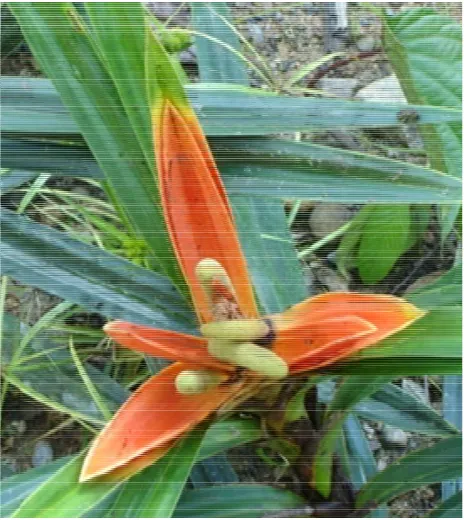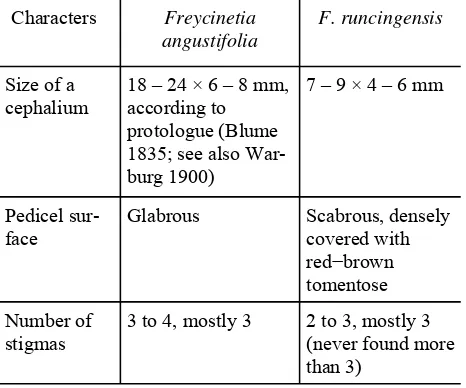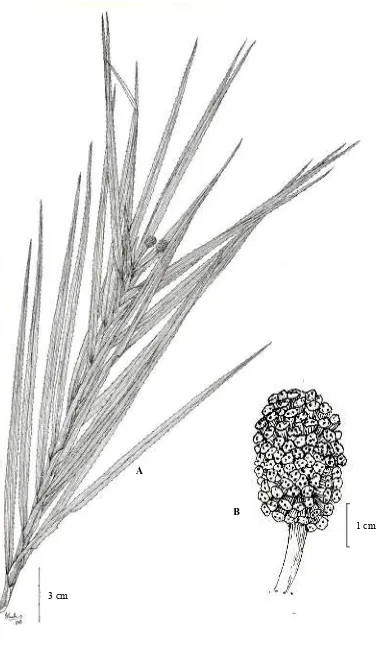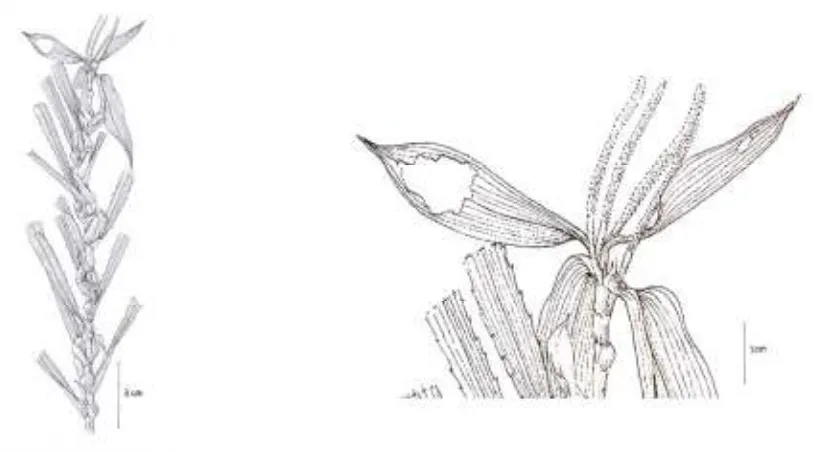Vol 13, Part 1, pp: 15 − 20
15
THREE NEW SPECIES OF FREYCINETIA (PANDANACEAE) FROM
KALIMANTAN, INDONESIA
Received February 26, 2009; accepted June 16, 2009
ARY PRIHARDHYANTO KEIM
Herbarium Bogoriense, Research Centre for Biology LIPI. Jl. Raya Jakarta Bogor Km 46, Bogor 16911, Indonesia.
ABSTRACT
KEIM, A.P. 2009. Three new species of Freycinetia (Pandanaceae) from Kalimantan, Indonesia. Reinwardtia 13(1): 15 –20. ⎯ Three new species of Freycinetia (Pandanaceae) from Kalimantan (Indonesian Borneo) are firstly described in this paper namely F. kartawinatae A.P. Keim, F. runcingensis A. P. Keim, and F. subracemosa A.P. Keim.
Keywords: Borneo, Freycinetia, Kalimantan, Pandanaceae.
ABSTRAK
KEIM, A.P. 2009. Tiga jenis baru Freycinetia (Pandanaceae) dari Kalimantan, Indonesia. Reinwardtia 13(1): 15–20. ⎯ Tiga jenis baru Freycinetia yaitu F. kartawinatae A. P. Keim, F. runcingensis A. P. Keim, dan F. subracemosa A. P. Keim dari Kalimantan dipertelakan untuk pertamakalinya dalam tulisan ini.
Kata kunci: Borneo, Freycinetia, Kalimantan, Pandanaceae.
INTRODUCTION
The Indonesian Borneo or Kalimantan consti-tutes the largest part of Borneo, which is approxi-mately 2/3 part of the island. Despite this fact, the pandan flora of Kalimantan, particularly for the ge-nus Freycinetia, is still largely unknown. Prior to this study, the most recent systematic study on the genus in Borneo was done by Stone (1970); how-ever, the information provided mainly concerns the Malaysian part (i.e. Sabah and Sarawak), whereas the data for Kalimantan was only briefly mentioned or appeared in the list of specimens examined. This paper describes the presence of three new species previously unknown to science, namely F.
kartawi-natae A. P. Keim, F. runcingensis A. P. Keim, and
F. subracemosa A. P. Keim.
Freycinetia kartawinatae A. P. Keim spec. nov. — Figs. 1–3.
Robustus scandens; caulis 30 mill. crasus; folia lin-eari−lanceolata, 43½ –44 cent. longa, 3 cent. lata; bractea auriantica, 22½–3 cent. longa; infructescentia terminalis, terna vel quaterna, pedicellis glabrous; syncarpia cylin-dricus, 9 cent. longi; stigmata 4 vel 5, plerumque 4. — Typus: Indonesia, West Kalimantan, Ka tingan Hulu, Waringin Timur, on logging road, 2 May 2006, A. P. Keim 770 (Holotypus–BO!).
Robust climbing pandan, climbing up to 50 m high. Stem ca. 9.5 cm circle (ca. 3 cm diameter).
Leaves spirally arranged in 3 ranks (tristichous); each lanceolate–elongate, ca. 43.5–44 cm long, ca. 3 cm wide, acuminate apex, margin with spines up to 1/3 distally; adaxial surface green, glabrous; abaxial surface pale green, glabrous; auricle ta-pered, margin integer, brownish yellow to creamy brown; leafsheath yellowish green. Infructescence
terminal, ca. 14 cm long, consists of 3 (ternate) to 4 (quaternate) spirally arranged cephalia; pedicel yel-low to pale yelyel-lowish orange, glabrous; bracts dis-tinctively bright orange, thick, hard, fleshy, gla-brous, acuminate apex, margin with spines, each boat shaped, ca. 22.5–23 cm long, caducous.
Cephalium cylindrical−elongate, ca. 9 cm long, ca. 3 cm wide, pale green to dull greyish green; stigma 4–5, mostly 4.
Distribution. Known only from the type locality.
Habitat and ecology. Lowland tropical rainforest at about 300 m altitude.
Etymology. After Kuswata Kartawinata, an Indone-sian ecologist and keeper of the Herbarium Bo-goriense (BO) 1981–1984.
Vernacular names. Kajak rajak, mèrajak (Dayak, Belaban dialect).
REINWARDTIA
16 [VOL.13
Notes. In general appearances, F. kartawinatae is very similar to F. insignis, but different in two mor-phological characters (Table 1).
Table 1. Morphological differences between F. kartawi-natae and F. insignis.
Regarding the more than three number of cephalia per infructescence thus indicates the sec-tion Polystachya, Borneo possesses at least one member, F. kinabaluana. However F. kartawinatae
differs from F. kinabaluana in several morphologi-cal characters (Table 2).
Table 2. Morphological differences between F. kartawi-natae and F. kinabaluana.
Freycinetia kuchenensis from Borneo known to have a lateral infructescence, reddish orange bracts, and 3 – 4 stigmas; however the two species differ on certain morphological characters (Table 3).
Table 3. Morphological differences between F. kartawi-natae and F. kuchenensis.
Characters F. kartawinatae F. insignis
Colour of the bracts
Orange Purplish white
Number of cephalia per in-fructescence
3 to 4 3
Characters F. kartawinatae F. kinabaluana
Position of in-fructescence
Terminal Lateral
Number of cephalia per infructescence
3 to 4 5 to 6
Shape of cephalium 9X3 cm 5 – 6X3.5–5 cm
Characters F. kartawinatae F. kuchenensis
Leaf dimension 43.5–44Xca. 3 cm to Martelli (1910)
Although possessing approximately similar length of leaf (40 – 60 cm) and 3 to 4 number of stigmas F. sarawakensis differs from F. kartawinatae in sev-eral characters (Table 4).
Table 4. Morphological differences between F. kartawi-natae and F. sarawakensis.
A taxon from Sarawak has many similarities with F. kartawinatae especially regarding the possession of orange bracts, terminal infructescences, and 3 to 4 cephalia per infructescence. This taxon was named
F. andersoniana by Stone (1967), but invalidly pub-lished.
Fig. 1. Freycinetia kartawinatae A.P. Keim. A terminal infructescence with 4 spirally arranged cephalia and very distinctive bright orange bracts. Photo: A.P. Keim, Rugayah & H. Rustiami.
Characters F. kartawinatae F. sarawakensis
Width of leaf 3 cm 0.5 to 0.7 cm
Fig. 2. Freycinetia kartawinatae A.P. Keim. A terminal infructescence with 3 spirally arranged cylindrical−elongate cephalia with yellow glabrous pedicels. The bracts have already fallen. Photo: A.P. Keim, Rugayah & H. Rustiami.
Fig 3. Freycinetia kartawinatae A.P. Keim (A. Leaves, B. Terminal infructescence with 4 spirally arranged cephalia). Drawn from the holotype (A.P. Keim 770–BO) by Wahyudi Santoso.
REINWARDTIA
18 [VOL.13
Characters Freycinetia angustifolia 1835; see also War-burg 1900)
7 – 9 × 4 – 6 mm
Number of stigmas
3 to 4, mostly 3 2 to 3, mostly 3 (never found more than 3)
Pedicel sur-face
Glabrous Scabrous, densely
covered with red−brown tomentose
Freycinetia runcingensis A.P. Keim spec. nov. — Fig. 4.
Gracilis scandens; auricula integra; in male inflores-centia bractea luteus clarus; pedicellus scabrous; stigmata 2 – 3, plerumque 3. — Typus: Indonesia, East Kaliman-tan, PT KEM area, Gunung Runcing, 0° 20’ S 115° 55’ E, 23 March 1997, Kessler et al. PK 2245 (Holotypus– BO!; Isotypus–L).
Slender climbing pandan, climbing up to 5 m high. Leaf ca. 20 cm long, ca. 0.5 cm wide, acumi-nate apex, integer margin except in lower most part and apex with minute spines; adaxial and abaxial surface glabrous; auricle tapered, smooth, integer margin. Male inflorescence with yellow bracts. In-fructescence terminal, ternate, ca. 3.5 cm long; pedicel obviously scabrous, densely covered with red−brown tomentose, 1.6 – 1.7 cm long. Cephal-ium globose, 7 – 9 mm long, 4 – 6 mm wide, with numerous berries. Berry small, 1 – 1.5 mm long; stigmas 2 – 3, mostly 3.
Notes. The differences between F. runcingensis and
F. angustifolia Blume are listed in Table 5. Frey-cinetia runcingensis has exceptionally smaller size of cephalium compared to F. angustifolia. The deci-sive difference between the two species is actually in the surface of the pedicel. F. runcingensis has conspicuously scabrous pedicel, while in F. angusti-folia it is shiny glabrous.
Table 5. Comparison of Freycinetia angustifolia and Frecynetia runcingensis.
Distribution. Only known from type locality.
Habitat and ecology. Lowland tropical rainforest and found along logging road at about 180 m alti-tude.
Etymology. After Gunung (Mount) Runcing, where the type was collected.
Conservation status. Probably Vulnerable (VU) due to limited area of distribution and the fact that the species has not been recollected.
Freycinetia subracemosa A.P. Keim sp. nov. — Fig. 5.
Gracilis scandens; inflorescentia masculis terminalis, spadicis quaterni, sub racemosus dispositus qui 3 spadicis spiralis dispositus dum 1 prominens infimus pedunculus; bracteis luteus ad aurantiacus. — Typus: Indonesia, Central Kalimantan, Km 23, Nyaru Menteng Arboretum, 113° 46.709’ E 02° 02.127’ S, 30 Oct. 1996, Kessler et al. PK 1575 (Holotypus–BO!; Isotypus–L).
Slender climbing pandan, climbing up to 6 m high. Stem ca. 0.5 cm diameter. Leaf lanceo-late−elongate, 23 – 25 cm long, ca. 0.8 cm wide, glabrous, acuminate apex, margin with minute spines; auricle present, lobed, apex pointed, papery, imbricate, integer margin, 1.5 – 2 cm long. Male inflorescence terminal, ca. 4.5 cm long, fragrant that resembles Cananga odorata; pedicel short, ca.
0.5 cm long; bracts yellow−orange, 3 – 5 cm long, 0.4 – 1 cm wide, each support a pedicel, the lower most being the largest; rachis 1.6 – 1.9 cm long; consists of 4 flowering branches, 3 arranged spirally while 1 raises from the lower part of peduncle, thus giving a subracemose appearance.
Field character. Climber, ca. 6 m tall, bracts yel-low−orange, flowers with very sweet smell like
Cananga odorata.
Distribution. Only known from type locality.
Habitat & ecology. Swamp forest along the Arbo-retum trail at about 35 m altitude.
Etymology. Named for the subracemose appear-ance of the male inflorescence.
Conservation status. Probably Vulnerable (VU) due to limited area of distribution and the fact that the species has not been recollected.
Notes. Although describing a new species of Frey-cinetia based on a staminate collection only is not common; however, this taxon (Kessler et al. PK 1575) possesses a unique structure of male inflores-cence. The male inflorescence consists of 4 flower-ing branches, in which 3 are spirally arranged and 1 appears from the lower part of peduncle, thus giving a subracemose appearance. The subracemose ar-rangement of flowering branches in a male inflores-cence is also observed in the Philippine species of
Fig. 4. Freycinetia runcingensis A.P.Keim (A. Habit, B. Globose cephalium. Drawn from the holotype (Kessler et al. PK 2245–BO) by Iskak Syamsudin.
A
3 cm
B
REINWARDTIA
20 [VOL.13
and Kalimantan (Keim et al., 2006). There are two other species in the section that share the slender habit with F. subracemosa, which are F. lucida
Martelli and F. vidalii Hemsley, but none has the distinctive sub racemose inflorescence
Table 6. Comparison of F. jagori and F. subracemosa
Fig. 5. Freycinetia subracemosa A.P. Keim (A. Habit 1x, B. Male inflorescence enlarged 2 1/2x showing the subracemose arrangement of male inflorescences). Drawn from the holotype (Kessler et al. PK 1575–BO) by Iskak Syamsudin.
ACKNOWLEDGEMENTS
The author would like to express his deepest gratitude to Dr. Rugayah and Ms. Himmah Rustiami (BO) for valuable discussions and information on Freycinetia of Kalimantan as part of the ongoing revision of Pandana-ceae of Kalimantan. Sincere appreciations are sent to Dr. Wayne Takeuchi (A) and Prof. Fukuoka (JICA) for wor-thy discussions and suggestions to the manuscript. Ap-preciation is sent to Dr. Teguh Triono (BO) for never ending in supporting the author.
REFERENCES
KEIM, A. P., RUGAYAH & RUSTIAMI, H. 2006. Keanekaragaman Pandanaceae di Taman Na-sional Bukit Baka Bukit Raya dan sekitarnya di Propinsi Kalimantan Barat. In ARIEF, A.J.; WALUJO, E.B.; MULYADI & JULISTIONO, H. (Eds.). 2006. Laporan Teknik Pusat Penelitian Biologi – LIPI 2006. Bidang Botani, Pusat Peneli-tian Biologi− LIPI, Bogor: 125–140.
MARTELLI, U. 1910. Enumerazione delle Pandana-ceae. Part 1: Freycinetia. Webbia 3: 307–327. STONE, B.C. 1967. Materials for a monograph of
Frey-cinetia (Pandanaceae) I. Gard. Bull. Sing. 22 (2): 129−152.
STONE, B. C. 1970. Materials for a monograph of Frey-cinetia Gaud. (Pandanaceae). VI. Species of Borneo. Gardens’ Bulletin Singapore 25 (2): 209– 233.
WARBURG, O. 1900. Pandanaceae. In ENGLER, A (Ed.). 1898−1923. Das Pflanzenreich 4. Part 9 ser. 3: 1–100.
Characters F. jagori F. subracemosa
Leaf dimen-arranged in 2 pairs, while 1 raises from the lower part of peduncle
4; 3 flowering branches spirally arranged, while 1 raises from the lower part of peduncle, thus giving a subracemose appearance
Auricle Tapered Lobed
Length of male flowering branch




